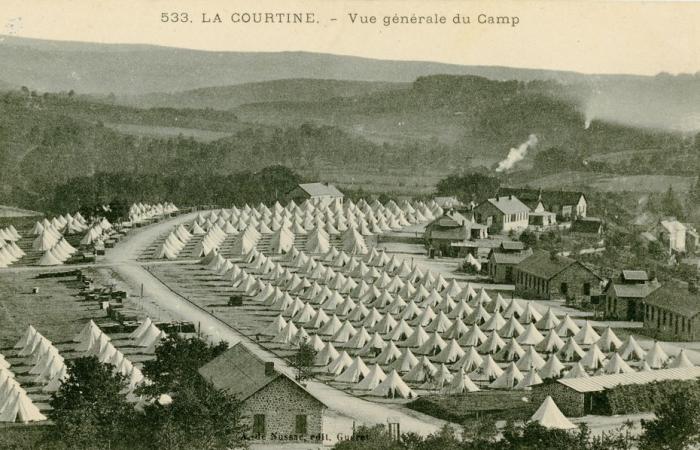It is not the best known, but it is nevertheless one of the most important military camps in France. Inaugurated in 1904, La Courtine has seen the history of France and beyond. Pétain and General de Gaulle passed through there, foreign troops remained there. A rich and unexpected story.
Company
From daily life to major issues, discover the subjects that make up local society, such as justice, education, health and family.
France Télévisions uses your email address to send you the “Society” newsletter. You can unsubscribe at any time via the link at the bottom of this newsletter. Our privacy policy
Three years after its creation, the La Courtine camp was officially opened on August 6, 1904. This immense camp, spread over 7,000 hectares (6,300 today) is located on the Millevaches plateau, south of the Creuse.
It then offers period comfort, large accommodation capacities, permanent barracks, kitchens, and a health service. At the beginning of the 20th century, before its creation, there was only one training center in France, in Chalons (Marne). La Courtine becomes the largest built center in France.
We must imagine a “playground” with almost lunar landscapes, moors as far as the eye can see before the wooded areas that we know today. You also have to imagine the sound of gunfire and bomb tests. Finally, the sound of the ballet of military and passenger trains. The last one left the station in 1988.
The La Courtine camp trains young soldiers, here with machine guns.
•
© © Paul Colmar
The camp took root against the backdrop of the 1870 defeat against Prussia. It was designed with the ambition of modernizing our army. From its opening, the beginnings of the 1914-1918 war made it a major rear base. An instruction center to prepare men for the front. The camp continued to expand, and work lasted until 1913. When the war broke out a year later, La Courtine became a detention camp. Then internment for captured German officers.
At the heart of the First World War, between 40 and 50,000 Russian soldiers were engaged alongside France thanks to an agreement concluded at the beginning of 1916. But when the Revolution broke out in February 1917, a good number of them wanted to return home. to participate. The wind of freedom breathed in by the provisional government made them challenge the authority of their hierarchy. They no longer want to fight in France.
What ignited the powder was the “Nivelle” offensive. The first Russian brigade was decimated in the Chemin des Dames operation. 5,000 Russians lost their lives, 30,000 French. The soldiers want more than anything to return home to enjoy the relative freedom recently acquired.
The option of sending the Russian mutineers home was not chosen by the French authorities who wanted to implement the agreement reached with their ally. Soldiers must fight. Especially since they are perceived as radicalized soldiers. France therefore moves the Russians several hundred kilometers from the front, into the rear zone, to return them to order and discipline, far from the major centers.
On June 26, 1917, 136 officers and 10,300 armed men of the Russian expeditionary force landed south of the Creuse to spend the summer of 1917 in the camp. Where prisoners of war already reside. For 3 months, the Russians made the inhabitants of the town of 1,500 inhabitants waltz.
My great-grandfather was a musician, he played the accordion. With his small group of 5 people, they were all singing. They went from farm to farm trying to get work. He was hired on a farm as a farmer. And that's where he met my great-grandmother and married her a year after arriving in the village.
Didier Yazlovetsky Cerf, descendant of a Russian soldier
In total, 16,500 Russians will stay in Creuse. Those we call the mutineers of La Courtine divide. Some want to surrender when the Russian command and the French army put pressure on them to surrender. Others don't.
Those who were allies, even friends the day before, are tearing each other apart. Result: 3 days of bombing, 9 dead and 49 injured. The two refractory brigades are dissolved. The survivors must choose between “returning to the front or joining work companies at the rear, otherwise it will be deportation to Algeria,” explains Eric Molodtzoff, grandson of a Russian soldier.
Also read : “So as not to forget the mutineers of La Courtine”
“Whatever the case, the deaths of La Courtine are deaths without name, without identity, deaths which nevertheless participated in the war alongside French soldiers,” writes Pascal Plas, director of the Chair of Excellence in Management. of conflict and post-conflict at the University of Limoges.
After the Second World War, where a German paratrooper unit was established in 1942, other foreigners arrived in Creuse. This time, they are allies. Due to a lack of sufficient space in Holland, conscripts from the Netherlands came to do their military service there in 1959-1964.
A convoy of 1,200 vehicles 40 kilometers long then crossed France. 6,000 men were present on the camp at the same time. Imagine, there were only 1,700 inhabitants in the village during this period.
We have 3,000 places for an infantry company and all its support.
Lieutenant-Colonel Jean-Jacques, the detachment leader of the Courtine camp, in 2015
Closer to us, in 2015, 800 men from the 17th Dutch Infantry Regiment came to La Courtine as a tribute to the (young) veterans. These troops from the 13th Dutch Light Armored Brigade were able to train and revive what had become a habit. Strong links between our two countries hailed by Queen Juliana herself, who came in person to Creuse during the heyday.
During the Russian summer of 1917 as during the Dutch presence, the village increased its activity. In the INA archives, notably in the filming of the program Five Columns on the Une in 1959, we can see the children of the village giving flowers to the Dutch soldiers. Who dance in bars and have fun with the boss.
Commerce was flourishing during the day, but we cannot fail to mention the nightlife. In the Creuse region, we repeat a phrase that has become cult: “If you go to La Courtine, watch your cock. »
Even before the creation of the camp, a so-called tolerance house was created there in the middle of the 19th century to fight against clandestine prostitution. La Courtine was then a garrison location.
The historian Romain Petit, professor of history, explained in a conference given in Creuse in 2017 that these houses were over-populated during the First World War and in the interwar period before being abandoned for clandestine prostitution. cafes.
Today, the camp is still operating. It obtained its autonomy in 2017. On the website of the Ministry of the Armed Forces, the camp is presented as a site with “advantageous geographical location”. “It has evolved to meet the contemporary needs of the army, particularly in terms of drones and support for external operations. »
A team from France 3 Limousin was able to follow commando training from all over France in January 2023 at La Courtine. A 96-hour exercise, in the snow (the site peaks at an altitude of 800 meters). Almost real conditions which echo the war in Ukraine.
Current events show us that there are a certain number of skills on which we must work. In particular heavy, armored and mechanized units to prepare for their engagement.
Valentin Seiler, Commander of Army training centers
The La Courtine site is designed specifically for the stay of large infantry units. These perfectly autonomous units take advantage of the numerous firing ranges. Developments have been made to double the surface area of the existing combat village: Saint-Maurice, named after the patron saint of the infantry. One hundred and ten houses offer real conditions for working on combat in urban areas (a module for acquiring tactical know-how in the jargon) and major maneuvers.
And in the surrounding countryside, several sites combine all conditions: forest, moor, ford crossings. Qualities already highlighted at the beginning of the 20th century. The camp also offers a drop zone for parachute units.
And that's not all, sound and image will very soon be added to existing arrangements to create stressful conditions and come even closer to real conditions. A construction site to accommodate helicopters will arrive very soon.
Certainly, attendance at the camp is no longer that of yesteryear. But more than 300 people still occupy the site permanently, including 154 civilian personnel, according to the Ministry of the Armed Forces. To which are added visitors for a day or a stay: between 500 and 2,000 soldiers come to train there every day.






